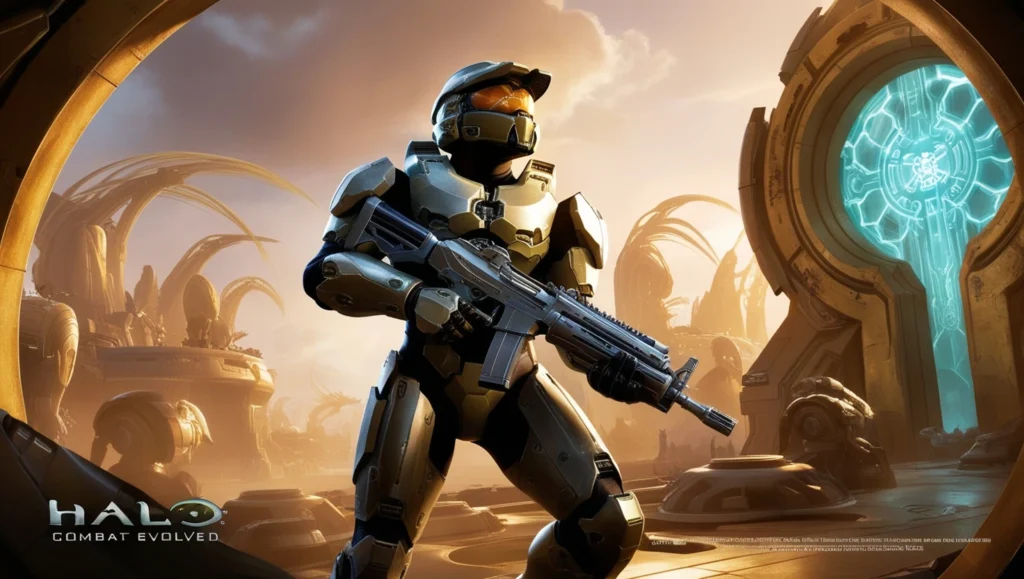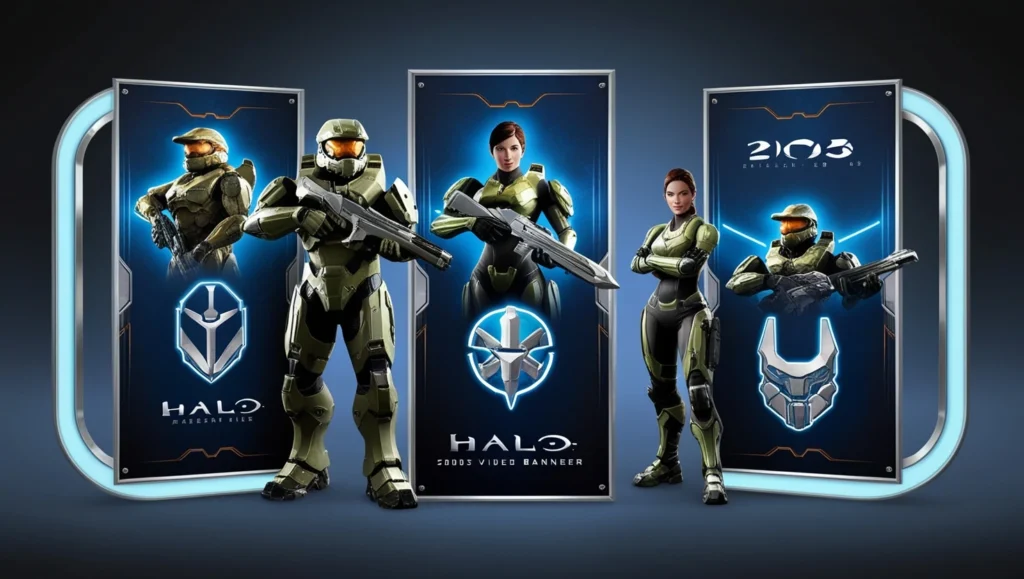
The Halo (2003) game icons banners were more than just pretty pictures; they were a cultural phenomenon that changed the way people played games. When it came out in 2003, Halo: Combat Evolved became a classic first-person shooter game with a story that kept people interested. But the game’s icons and flags helped cement its place in the annals of video game history. Not only did these things help players find their way in Halo’s huge world, they also became symbols of a community that still exists and grows. This blog will talk about what Halo (2003) game icons banners mean, how they were made, and how they have affected culture.
Understanding Halo (2003) Game Icons Banners
Game icons for Halo (2003) banners are important visual symbols in the game. They hold important parts of the game’s world in small, easily recognizable shapes. The story and gameplay of the game heavily rely on icons such as the Master Chief’s hat and the Covenant mark. For example, the Master Chief’s helmet represents bravery and the player’s character, whereas the Covenant logo represents the bad guys that players must fight. These graphics improve the user experience by making it simple to recognize characters, groups, and game features right away.
On the other hand, banners are larger artworks designed for advertising purposes. They usually have beautiful art that shows off important characters and outstanding fights from the game. The posters for Halo (2003) game icons made people feel like they were on an exciting journey before they even picked up a controller. All of these visual features work together to make an immersive experience that makes both the story and the games better.
The Design Philosophy Behind Halo (2003) Game Icons Banners
The idea behind the Halo (2003) game icons banners comes from wanting to make images that are both beautiful and useful. We carefully crafted each icon to ensure it resonated with players on multiple levels. For example, the Master Chief Icon, which is a stylized figure in green armor, came to represent bravery and adventure. This design choice not only shows what the character is like, but it also makes players feel strong.
In the same way, the UNSC logo, which is an eagle sitting on top of a world, stresses the fight against alien dangers. This symbol represents the main ideas of the game’s story, which are life and strength. With its sharp edges and strange look, the Covenant Icon makes a striking representation of the evil guys. These design choices make it easier for people to connect emotionally with the game and create a visual language that runs through the whole Halo world.
Types of Icons and Banners in Halo (2003)
The Halo (2003) game features a variety of icons and banners that enhance the player’s experience.
- Player emblems are modifiable icons that let gamers show who they are in the community. Players can show off their achievements with unique patterns that showcase their own style.
- Achievement-Based Icons: Directly linked to game achievements, these icons serve as badges of honor for completing tasks or achieving high scores. Unlocking these marks motivates players to engage more with the game.
- Advertising banners often feature dramatic pictures of Master Chief battling aliens or engaging in epic battles on distant worlds. By highlighting new material, they help build interest before the game comes out and during expansions.
Summary Table of Icons
| Icon | Description | Significance |
| Halo Logo | Stylized ring with futuristic font | Represents the game’s title and identity |
| Master Chief Icon | Silhouette of Master Chief in armor | Symbolizes the game’s protagonist |
| Covenant Icon | Angular, alien design | Represents the game’s antagonist faction |
This table summarizes some of the most iconic visuals from Halo (2003) game icons banners, showcasing their significance in creating a memorable gaming experience.
Summary Table of Banners
| Banner | Description | Purpose |
| Launch Banner | Dramatic artwork featuring Master Chief and enemies | Promoted the game’s initial release |
| Expansion Pack Banner | Updated visuals reflecting new content | Highlighted new features and expansions |
| Anniversary Banner | Blend of nostalgic and modern graphics | Celebrated the game’s 10th anniversary |
This table highlights key promotional materials that played a crucial role in shaping public perception of Halo (2003) game icons banners while providing insights into their intended purposes.
Historical context and evolution
Understanding the meaning of the Halo (2003) game icons, banners, and flags requires familiarity with their historical background. People had high hopes for Halo: Combat Evolved when it came out in 2001 as the main game for Microsoft’s Xbox system. It had new game modes and beautiful graphics. In a market full of rivals, the marketing team knew right away that images that stood out would be key to getting people’s attention.
The launch banner had dramatic art of Master Chief fighting alien monsters, which emphasized the immersive gameplay and showed off the amazing graphics that were new at the time. As Bungie worked on Halo sequels like Halo 2 and Halo 3, they continued to refine their aesthetic. Icons got more complicated while still keeping key elements from Halo (2003). This change maintained the interest of existing fans and attracted new players due to the improved aesthetics.
As gaming technology improved over time, so did people’s standards for how well video games looked. The original designs for Halo (2003) set a strong standard for future games in the series and impacted games of all types, showing how effective visual branding can have long-lasting effects on an entire industry.
Cultural Impact of Halo (2003) Visuals
Banners with Halo (2003) game icons have had a deep and wide-reaching effect on culture. These images, long after their initial release, fostered a sense of community among players. Many skilled artists transformed the famous designs into their own creations, ranging from detailed drawings to humorous memes shared on social media sites.
A lot of people bought items with these images on them. Action toys with well-known symbols ended up in homes all over the world, and clothing lines used logos that fans really liked. Online discussions about these images are popular in gaming forums, where fans share their experiences with specific icons or banners, creating rich narratives closely linked to their own gaming memories.
Also, nostalgia is becoming a bigger part of modern gaming culture, especially among older players. People still find the graphics from Halo (2003) relevant today, as they evoke powerful emotions that connect directly to significant experiences they had in that game.

Creating Custom Icons and Banners
Banners with icons from the 2003 game Halo have had a big impact on society. Long after these pictures became public, players continued to experience a sense of belonging. Many skilled artists created their own versions of the well-known designs, ranging from detailed drawings to humorous Facebook memes, as part of fan art culture.
Many people purchased items featuring these images. Some people worldwide own action toys adorned with well-known symbols, and clothing brands have adopted logos that are highly favored by their fans. Many people discuss these pictures online in gaming groups. Fans share their experiences with specific icons or banners, creating narratives that closely connect to their personal gaming memories.
Another issue is that nostalgia is increasing in today’s gaming society, particularly among older gamers. Images from Halo (2003) remain useful today, evoking strong emotions linked to significant events in the game.
Fan Culture Surrounding Halo (2003) Game Icons Banners
It’s interesting to see how fan society has changed over time to accept Halo 3 game icons posters. Early forums, where fans could discuss strategies or lore related to this popular franchise, grew into active communities where fans shared their own designs based on official ones. These ranged from simple banners showing off personal achievements in multiplayer games to complex player emblems with variations on UNSC logos.
These fan-made items greatly increased the societal influence and longevity of Halo. Players greatly expanded their personal meaning by reinterpreting existing visuals through personal lenses, whether through fan art depicting different scenarios involving characters like Cortana or humorous memes mocking the game’s mechanics. This also strengthened the connections they made through shared experiences with the original content of this iconic game.
Conclusion
In conclusion, the Halo (2003) game icons banners changed not only how games are played but also how visual elements are used in gaming culture in general. This game’s graphics have become famous, both in the hearts of players and in the eyes of the business as a whole. The flags and icons of the game play a crucial role in fostering a sense of belonging and fostering community connections as players immerse themselves in this exquisitely designed world brimming with adventures.
As we honor these visual elements today, whether through online conversations about the past or creative projects sparked by them, it’s clear how important they are, not only for those who experienced them firsthand, but also for future generations who want to know what makes this legendary game so special. Accept these visual features as you discover all that Halo still has to offer!
FAQs About Halo (2003) Game Icons Banners
What are Halo (2003) game icons?
In Halo (2003), game icons are small pictures that stand for important parts of the game, like characters, weapons, and awards.
What purpose do banners serve in Halo (2003)?
Banners are larger advertisements that are used to encourage people to play and to draw attention to important parts of the game, such as characters and great fights.
How do icons enhance gameplay?
Icons make it simple to quickly recognize important game features, which makes it easier to move around and enjoy the game.
Can players customize their icons in Halo (2003)?
Yes, players can make their own player badges that show off their style and accomplishments.
What is the significance of the Master Chief icon?
The Master Chief icon represents the main character of the game. As well as all the bravery and excitement in the Halo world.
Are there achievement-based icons in Halo (2003)?
Yes, achievement-based icons do reward players for reaching certain goals or challenges in the game.
How did Halo (2003) influence later games?
Halo’s (2003) use of visual design and branding paved the way for future games to use icons and sell themselves.
Where can I find original Halo (2003) designs?
Fan sites, official merchandise shops, and Halo-themed community groups are all excellent places to find original ideas.
What role do fan creations play in Halo culture?
Fan works contribute to the game’s history by allowing players to reinterpret images. This encourages creativity and community involvement.
Why are Halo’s (2003) visuals still relevant today?
The memories and emotional connections that the graphics in Halo 3 evoke still move both new and old players.
Also read about The Fallout Craze review